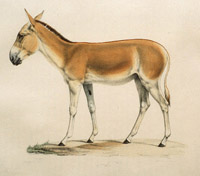
Erforschung biologischer Ressourcen der Mongolei / Exploration into the Biological Resources of Mongolia, ISSN 0440-1298
Date of this Version
2007
Document Type
Article
Citation
Erforschung biologischer Ressourcen der Mongolei (2007) band 10: 347-357.
Abstract
Asiatic wild asses were once found across central Asia, but over time their range has been reduced until today all subspecies are under threat. This paper examined the literature about wild asses with an aim to illustrating gaps in our knowledge as a target for future research.
A search was made on BIOSIS ISI for the following strings: Equus hemionus, wild ass, khulan, kulan, kiang, khur, and onager. In total 61 relevant references were found, published between 1900 and 2005. Most of these references were published in the 1990s, with only one published between 1900 and 1970. Khur and khulan were most under-represented in the literature with only five and two citations respectively resulting from these key words. When put into subjective categories most papers published (28) were on the conservation, behavior or ecology of Asiatic wild asses. All physiology papers dealt with captive animals, and nearly half of all genetics papers focused on onagers. Very little was published on the habitat use of wild asses and there was almost nothing on the distribution of subspecies, or genetic differences between them. This research highlighted the importance of key words and consistent nomenclature. We need to focus more on the ecology of wild populations, in particular examining habitat use, social structure and distribution. In addition it is very important that more is published on threats to these animals so that action can be taken in time.
Included in
Asian Studies Commons, Biodiversity Commons, Environmental Sciences Commons, Nature and Society Relations Commons, Other Animal Sciences Commons, Population Biology Commons, Terrestrial and Aquatic Ecology Commons, Zoology Commons


Comments
Copyright 2007, Martin-Luther-Universität Halle Wittenberg, Halle (Saale). Used by permission.